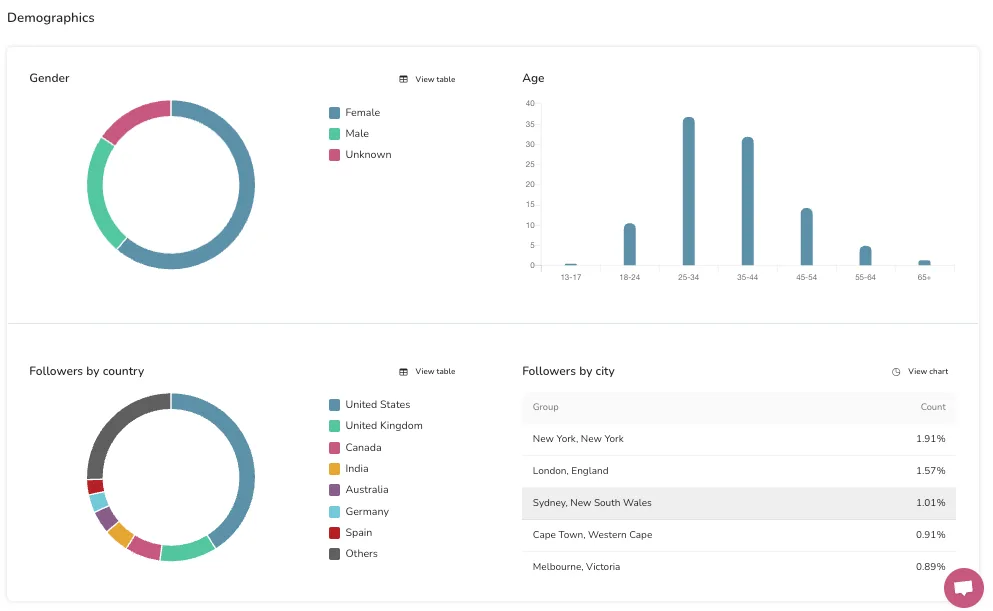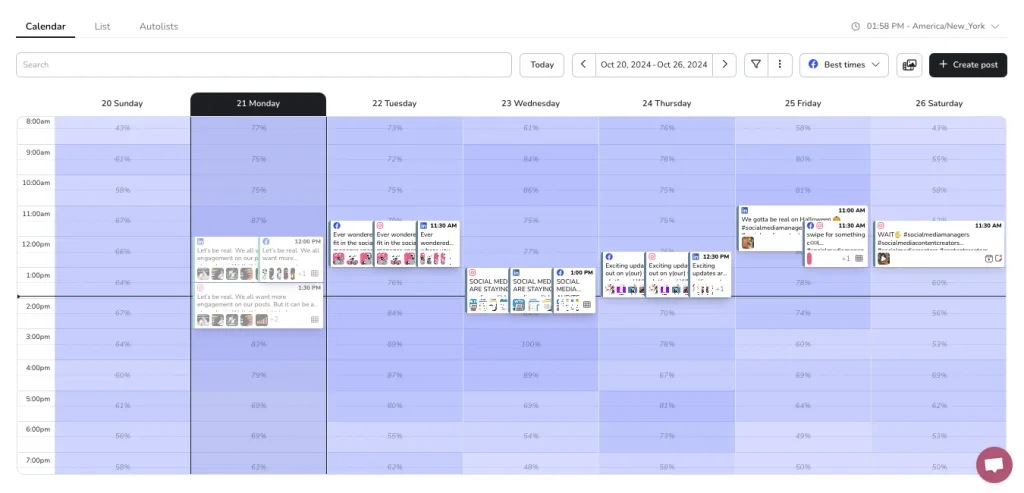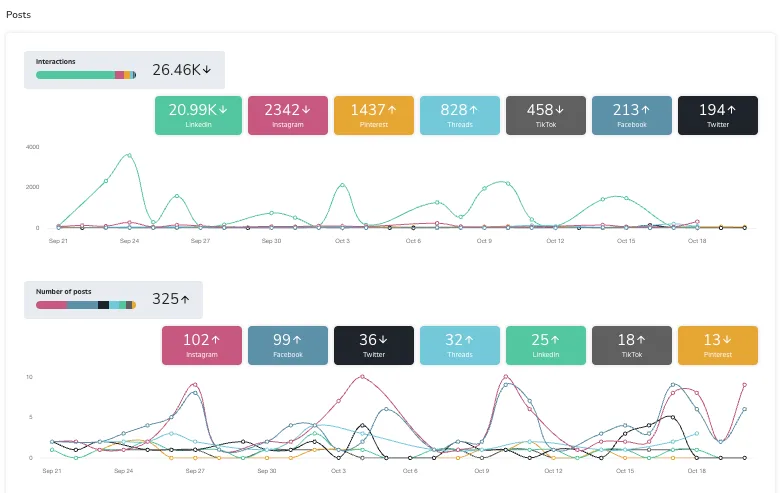The Importance of Content Pillars for a Social Media Strategy

Content pillars are the backbone of your social media strategy, helping keep your brand on track and true to voice.
Besides organizing your plan, content pillars mobilize your social media goals and consistency. Stay tuned to understand content pillars better and identify these key terms for your brand.
What Are Social Media Content Pillars?
Also called content categories or clusters, content pillars lay the foundation of what content, conversations, and resources you share with your audience.
How many content pillars should you have? Three to five is the sweet spot, allowing for content diversification but not too many topics to become overwhelming. These should also relate to the goals you want to achieve on social media.
Content pillars aren’t chosen at random. They are the core of an SEO strategy, matching content topics to your target audiences’ search terms. With social media’s highly competitive landscape, brands should focus on these niche terms and interests to boost organic rankings and traffic.
Why Are Content Pillars Important for Social Media?
Content pillars are a long-term social media strategy that helps authentically communicate your products and services. Having these topics in your back pocket makes content planning much easier. Here are a few more advantages of using content pillars:
- Control your brand narrative: Drive your brand voice by implementing your company values and vision into your content. This helps increase brand recognition and trust.
- Branding consistency: Not only do content pillars streamline your brand voice, but give users an idea of what to expect from your social media pages. Plus, algorithms love consistency, helping boost your organic rankings.
- Content organization: A steady stream of content topics on your calendar ensures you cover all your business bases and provide diversified content to your audience.
- Increase authority in your space: Become a go-to expert in your niche by providing educational resources, pro tips, and entertainment.
- Create relevant content: Your brand can provide valuable content based on your audience’s needs and desires, becoming a relevant source for your audience.
- Efficiency in Content Creation: With clear themes, content creation becomes more streamlined. You can even repurpose content across different pillars and formats.
- Measurement and Optimization: Pillars make it easier to track which types of content perform best, allowing you to optimize your strategy over time.
Why You Can’t Afford to Skip Content Pillars
If you’re still wondering if content pillars are truly necessary, let’s highlight the undeniable advantages they offer for busy social media managers:
- Cuts Down on Content Creation Time: This is a huge one. When you know your core topics, brainstorming becomes focused and efficient. Instead of asking “What should I post today?”, you ask “What piece of content can I create that fits under my ‘Educational Content’ pillar this week?”
- Boosts Brand Recognition and Recall: Think about brands you admire on social media. They usually have a distinct “vibe” and cover certain topics consistently. That’s content pillars at play. When your content consistently revolves around specific themes, your audience starts to associate your brand with those topics, building a stronger brand identity and recall.
- Enhances Audience Engagement: Generic content gets scrolled past. Relevant, valuable content stops the scroll. By aligning your pillars with your audience’s pain points, interests, and aspirations, you create content that truly resonates and encourages interaction.
- Improves Your Social Media ROI: When your content is strategic and engaging, it naturally performs better. Better performance means more reach, more engagement, more leads, and ultimately, a better return on your social media investment.
- Facilitates Team Collaboration: If you work with a team of content creators, pillars provide a shared understanding of what needs to be created. Everyone is on the same page, reducing miscommunications and ensuring consistency.
- Simplifies Content Audits and Performance Analysis: When your content is categorized by pillars, it’s much easier to analyze what’s working and what’s not. You can see which pillars drive the most engagement, conversions, or brand awareness, allowing for data-driven adjustments to your strategy.
- Provides a Roadmap for Future Growth: As your brand evolves, your content pillars can too. They provide a flexible yet structured framework for adapting to new trends, product launches, or audience shifts without losing your core identity.
Without content pillars, you’re essentially throwing spaghetti at the wall to see what sticks. With them, you’re a master chef, meticulously crafting a delicious and consistent menu that keeps your audience coming back for more.
Content Pillar Examples
To better understand content pillars, let’s look at a few possible examples:
- A monthly clothing subscription company may create content about fashion inspiration, clothing trends, and subscription benefits.
- An indoor cycling studio may have content pillars such as cycling education, health and wellness tips, and the benefits of cycling.
- A dentist’s office could have content pillars like dental education, how-to’s and tutorials for healthy teeth, and dentist humor.
While these are fictional examples, these broad topics define content ideas to align with a brand’s overall strategy.
How to Create Content Pillars for Social Media
Building robust content pillars isn’t a complex process, but it requires thoughtful planning and a deep understanding of your brand and audience. Here’s a step-by-step guide to laying your foundation:
Step 1: Define Your Core Business & Social Media Goals
Before you even think about content, you need to know why you’re on social media. What do you want to achieve? Your content pillars must directly support these objectives.
- Brand Awareness: Do you want more people to know about your brand? Your pillars might focus on broad educational topics or entertaining content that introduces your brand.
- Lead Generation/Sales: Are you looking to drive conversions? Pillars might include product highlights, testimonials, or problem-solution content.
- Community Building/Engagement: Is your goal to foster a loyal community? Pillars could revolve around user-generated content, Q&As, or behind-the-scenes glimpses.
- Thought Leadership: Do you want to be seen as an industry expert? Educational content, industry insights, and trend analysis would be key pillars.
- Customer Support/Education: Are you aiming to answer common questions and provide value to existing customers? Tutorials, FAQs, and troubleshooting tips fit here.
Metricool Tip: Use the SMART framework for your goals: Specific, Measurable, Achievable, Relevant, and Time-bound. For example: “Increase Instagram engagement rate by 15% within the next quarter.”
Step 2: Know Your Audience Inside Out
This is arguably the most critical step. Your content pillars are only effective if they resonate with your target audience. You need to understand:
- Demographics: Age, gender, location, occupation, income level.
- Psychographics: Interests, values, attitudes, lifestyle, personality traits.
- Pain Points & Challenges: What problems do they face that your brand can help solve?
- Aspirations & Goals: What do they want to achieve?
- Content Preferences: What kind of content do they consume on social media? (e.g., short-form video, long-form educational posts, inspiring visuals, quick tips).
- Preferred Platforms: Where do they hang out online? (e.g., Instagram, TikTok, LinkedIn, Facebook, X).
How to gather this information:
- Social Media Analytics: Your Metricool dashboard is a goldmine! Dive into audience insights to see demographics, activity patterns, and top-performing content.
- Surveys & Polls: Ask your existing audience directly what they want to see more of.
- Customer Feedback: Look at reviews, comments, DMs, and customer support inquiries. What questions do they frequently ask? What are their common concerns?
- Competitor Analysis: See what your competitors are doing well (and not so well). What topics are they covering? What content is getting engagement?
- Keyword Research: Use tools (like Google Keyword Planner or SEMrush) to see what terms your audience is searching for online related to your industry.

Source: Metricool Analytics
How can you find keywords? There are a few free tools you can use to view trends, patterns, and search volumes:
- Google Trends: Understand what people search for on Google, grasping a large-scope view of trending topics and search terms. Narrow your results by category, region, language, and period to nail down relevant answers.
- Answer the Public: Analyze search terms for Google, Bing, YouTube, TikTok, and Amazon to see common pain points and questions.
- Pinterest Trends: View the top monthly, yearly, seasonal, and growing search terms on Pinterest. Filter by date, interests, keywords, age, and gender for narrowed results.
- TikTok Creative Center: With this tool, view the top hashtags, songs, creators, and TikTok videos on the platform. While this helps you find relevant keywords, gain inspiration from top-performing content.
- Instagram Search: This is a simple way to view top keywords and content by term. Take note of the content and brands positioned in the first positions.
For more information about keyword research, make sure to follow this guide:
Metricool Tip: Create detailed buyer personas for your ideal audience segments. Give them names, backstories, challenges, and aspirations. This makes creating content for them feel much more personal and effective.
Step 3: Brainstorm Potential Content Topics
Now, with your goals and audience insights firmly in mind, it’s time to brainstorm. This is where you let creativity flow!
- List everything: Write down every single topic, question, idea, or problem related to your brand, industry, and audience interests. Don’t filter at this stage.
- Think broad: What are the major themes that naturally emerge?
- Consider different angles: How can you approach a topic from an educational, entertaining, inspirational, or promotional perspective?
- Review past content: What posts have performed well for you in the past? What common threads do they share?
- Look at trends: What’s currently trending in your industry or on social media platforms that you can tie into?
Example Brainstorm (for a sustainable fashion brand):
- How to care for clothes
- Sustainable material facts
- Ethical manufacturing processes
- Behind the scenes at our factory
- Meet the artisans
- Recycling old clothes
- Styling tips for eco-friendly outfits
- New collection launch
- Discount codes
- Customer testimonials
- Why slow fashion matters
- Industry news on sustainability
- Fashion events
- Outfit of the day (OOTD) with our clothes
- Q&A with our founder
- Our mission and values
- Polls on fashion choices
- Giveaways
Step 4: Group & Categorize into Pillars
This is where the magic happens. Look at your brainstormed list and start grouping related ideas under broader themes. Aim for 3 to 5 (maximum 7) content pillars. Too few, and your content might become repetitive; too many, and you lose focus and consistency.
Each pillar should be:
- Broad enough to generate many content ideas.
- Specific enough to be clearly distinguishable from other pillars.
- Aligned with your brand, goals, and audience interests.
Let’s take our sustainable fashion brand example and group it:
- Education & Awareness: Content focused on informing the audience about sustainable practices, materials, and industry issues.
- Sub-topics: Sustainable material facts, why slow fashion matters, ethical manufacturing processes, recycling old clothes, industry news on sustainability.
- Style & Inspiration: Content that showcases how to wear and style sustainable fashion, offering creative ideas.
- Sub-topics: Styling tips for eco-friendly outfits, OOTD with our clothes, fashion events, outfit challenges.
- Brand Story & Values: Content that highlights the brand’s mission, transparency, and the people behind the products.
- Sub-topics: Behind the scenes at our factory, meet the artisans, our mission and values, Q&A with our founder, testimonials (authenticity).
- Products & Promotions: Content focused on showcasing new collections, products, and driving sales.
- Sub-topics: New collection launch, product highlights, discount codes, giveaways, customer testimonials (product-focused).
Notice how these pillars cover different aspects of the brand and serve different purposes (educate, inspire, build trust, sell). This diversification keeps your content fresh and engaging.
Step 5: Define Content Buckets/Formats for Each Pillar
Once you have your pillars, think about the different types of content you can create within each. This helps with repurposing and ensuring variety.
- Educational: Carousels, infographics, how-to guides, tutorials, explainer videos, quick tips, blog post snippets.
- Inspirational: High-quality photos/videos, motivational quotes, success stories, mood boards, aesthetic reels.
- Entertaining: Skits, memes, relatable scenarios, behind-the-scenes bloopers, challenges, trending audio usage.
- Promotional: Product demos, customer testimonials, before & afters, limited-time offers, new arrival announcements, user-generated content featuring products.
- Community/Engagement: Polls, Q&As, quizzes, “this or that,” “ask me anything” (AMA) sessions, discussions, shoutouts to community members.
Metricool Tip: Different platforms excel at different formats. An educational carousel for Instagram could become a quick tip video for TikTok or a detailed LinkedIn post. Repurpose, repurpose, repurpose!
Step 6: Map Content to Your Pillars & Create a Content Calendar
With your pillars and content buckets defined, you now have a clear roadmap. The next crucial step is to organize your ideas into a content calendar.
- Allocate content to pillars: Plan to post from each pillar regularly. For example, you might aim for a mix like: 40% Educational, 25% Inspirational, 20% Promotional, 15% Brand Story. This ensures balance and prevents your feed from becoming overly promotional.
- Vary formats: Don’t just post photos. Incorporate videos, Reels, Stories, carousels, text-only posts, and live sessions.
- Plan in advance: Use Metricool’s planning features to schedule your posts weeks or even months ahead. This reduces last-minute stress and ensures consistency.
- Include key dates: Integrate product launches, holidays, industry events, and campaigns into your calendar.
- Assign responsibilities: If you have a team, clearly assign who is responsible for creating which piece of content for each pillar.

Metricool Tip: Our content calendar is your best friend here. You can visually plan your pillars, see your content mix, and schedule posts across all your platforms from one unified dashboard. This makes implementation seamless.
Step 7: Analyze, Adapt, and Optimize
Content pillars aren’t set in stone. The social media landscape is dynamic, and so should your strategy be.
- Monitor Performance: Regularly use Metricool’s analytics to track how content from each pillar is performing.
- Which pillars generate the most engagement (likes, comments, shares, saves)?
- Which drive the most reach and impressions?
- Which lead to website clicks or conversions?
- Identify Trends: Are certain sub-topics within a pillar performing exceptionally well? Lean into those. Are others falling flat? Re-evaluate.
- Gather Feedback: Listen to your audience. What are they asking for? What do they respond to?
- Adjust as Needed: Don’t be afraid to tweak your pillars, add new sub-topics, or even remove a pillar if it’s no longer serving your goals or resonating with your audience. Social media is about continuous improvement.
This iterative process ensures your content strategy remains fresh, relevant, and highly effective.

Alternatively, analyze each channel in detail with one click. Select the network to examine community growth, demographic information, profile impressions and clicks, and content performance. View your most successful posts per channel to see what content resonates best with your audience. This is key for determining content pillars.
Curious about which hashtags perform best for your Instagram and TikTok pages? We have you covered. See which hashtags bring you the most impressions, likes, and comments to consider these keywords for your strategy.

Analyze your industry competitors on Facebook, Instagram, X, YouTube, and Twitch to benchmark your content against similar brands. After gathering your tangible content performance metrics, identify successful content patterns and topics to determine your brand’s ideal pillars.
Executing a Content Strategy with Metricool
At Metricool, we understand that social media managers need efficiency, insights, and seamless execution. Our platform is built to support your content pillar strategy every step of the way:
- Unified Planning: Create, organize, and schedule content for all your pillars across every platform from one intuitive calendar.
- Audience Insights: Dive deep into demographic and behavioral data to inform your pillar development and ensure relevance.
- Performance Tracking: Analyze the success of your content across different pillars, identifying what resonates most with your audience.
- Content Library: Store and easily access your pillar-specific content, making repurposing and consistency simple.
- Best Times to Post: Optimize your posting schedule based on when your audience is most active, ensuring your pillar content gets maximum visibility.
- Team Collaboration: Share your pillar strategy and content calendar with your team, streamlining workflows and approvals.
Content pillars are not just a theory; they are a practical, actionable framework that will transform your social media efforts. They move you from reactive posting to proactive strategizing, ensuring every piece of content serves a purpose and contributes to your overarching brand goals.
Build Your Pillars, Build Your Brand
In the competitive world of social media, consistency, relevance, and value are the cornerstones of success. By thoughtfully defining and consistently applying your social media content pillars, you’re not just creating posts; you’re building a powerful, recognizable brand narrative that resonates deeply with your audience.
So, ditch the content creation anxiety. Embrace the power of pillars. Start laying your foundation today, and watch your social media presence ascend to new heights. With Metricool by your side, managing your magnificent content structure will be more organized, efficient, and impactful than ever before. Sources

